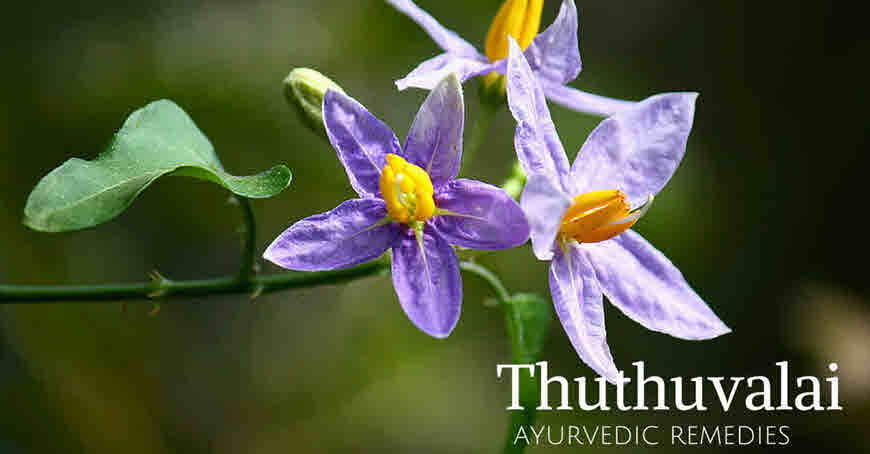Thuthuvalai or Climbing Brinjal is a medicinal plant commonly available in Southern India. This plant belong to family Solanaceae. Solanaceae is Potato or Nightshade family and some important members of this family are Eggplant, Tomato, Capsicum, Datura, Tobacco, Brihati, Kantakari, etc. Scientific name of clmbing brinjal is Solanum trilobatum and it is used traditionally for curing numerous diseases such as asthma, cough, and tuberculosis. For the medicinal purpose whole plant is used.

General Information
Latin name: Solanum trilobatum Linn.
Family: Solanaceae
Vernacular names
- SANSKRIT: Alarka, Vallikantakaarika, Kantakaari-lata
- ENGLISH: Climbing Brinjal
- HINDI: Kantakaari-lataa
- MALAYALAM: Padarchunda, Parachunda, Tootuvila
- MARATHI: mothiringnee, thoodalam.
- TAMIL: Tuduvalai, Nittidam, Sandunayattan, Surai, Thuthuvalai
- TELUGU: Alarkapatramu, kondavuchinta, mullamustil
- KANNADA: Kakamunji, Ambusondeballi.
- ORIYA: Bryhoti
Plant description
Perennial bright green prickly diffuse plant, reaches up to 2–3 m height;Leaves deltoid or triangular, irregularly lobed;Flowers purplish-blue, in cymes;Fruits or berries globose, red.
Distribution: Throughout India, growing wild, open areas, waste lands.
Folk Medicinal Uses
Climbing brinjal is a thorny creeper commonly found in Deccan Peninsula. It’s some common names are Alarka (Sanskrit), Tutuvalam (Malayalam), Alarkapatramu (Telugu) and Tuduvalai (Tamil). Various parts of the plant such as roots, berries and flowers are used for treating respiratory ailments. The decoction of berries and flowers is folk remedy for cough and chronic bronchitis. The leaves are given to increase fertility in males by treating watery semen and spermatorrhoea. In Siddha, medicated ghee of leaves is medicine for tuberculosis and lung congestion. The leaves and fruits of the plant contains many phytochemicals such as steroidal alkaloid and solasodine, etc. due to which plant exhibits antimitotic, anti-tumor, antibacterial and antifungal activities.
Improving strength
The unripe fruits are prepared as curry or roasted in sesame oil and taken orally along with food.
Itching, cough
The leaf juice is taken orally to treat cough and itching.
Cough
For cough, whole plant of Solanum trilobatum is used. Fresh plant is washed and ground to form a paste. This paste is taken orally in a dose of 1 teaspoon with one cup hot milk.
Excessive cough, tuberculosis, congestion of lungs
Take about 1/8 cup leaves and one cup Gau-ghrita/cow’s ghee. Boil the leaves in ghee till all water evaporates and only ghee remains. This is medicated ghee of Solanum trilobatum leaves. This ghee should be taken every day.
Hearing problems
- The leaves juice is put in ears as ear drop.
- Spermatorrhoea, Physical weakness
- Spermatorrhoea means abnormally frequent and involuntary non orgasmic emission of semen.
- This home remedy requires decoction of flowers of Solanum trilobatum. Few flowers are boiled in 2 glasses of water till the volume is reduced to 1 glass. This filtered and taken.
Spermatorrhoca, watery semen
The flowers of Solanum trilobatum (2 teaspoon) are fried in ghee and taken with yoghurt.
It is called as “Leipung khang” in Manipuri. Along with honey we used to take during cold and cough.
Very useful data for people like me who believe in amazing curative properties of certain useful herbals.Thank you.